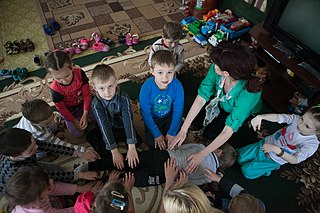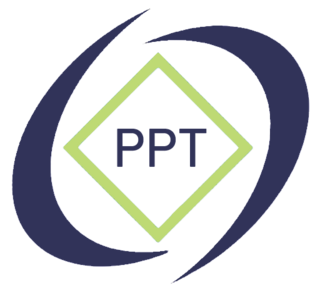Related Research Articles
Psychotherapy is the use of psychological methods, particularly when based on regular personal interaction, to help a person change behavior, increase happiness, and overcome problems. Psychotherapy aims to improve an individual's well-being and mental health, to resolve or mitigate troublesome behaviors, beliefs, compulsions, thoughts, or emotions, and to improve relationships and social skills. Numerous types of psychotherapy have been designed either for individual adults, families, or children and adolescents. Certain types of psychotherapy are considered evidence-based for treating some diagnosed mental disorders; other types have been criticized as pseudoscience.
Gestalt Theoretical Psychotherapy(GTP) is a method of psychotherapy based strictly on Gestalt psychology. Its origins go back to the 1920s when Gestalt psychology founder Max Wertheimer, Kurt Lewin and their colleagues and students started to apply the holistic and systems theoretical Gestalt psychology concepts in the field of psychopathology and clinical psychology. Through holism, "a person's thinking, feeling, actions, perceptions, attitudes and logical operations" are seen as one unity. Many developments in psychotherapy in the following decades drew from these early beginnings, like e.g. group psychoanalysis (S. Foulkes), Gestalt therapy (Laura Perls, Fritz Perls, Goodman, and others), or Katathym-imaginative Psychotherapy (Hanscarl Leuner).
Clinical psychology is an integration of human science, behavioral science, theory, and clinical knowledge for the purpose of understanding, preventing, and relieving psychologically-based distress or dysfunction and to promote subjective well-being and personal development. Central to its practice are psychological assessment, clinical formulation, and psychotherapy, although clinical psychologists also engage in research, teaching, consultation, forensic testimony, and program development and administration. In many countries, clinical psychology is a regulated mental health profession.
Integrative psychotherapy is the integration of elements from different schools of psychotherapy in the treatment of a client. Integrative psychotherapy may also refer to the psychotherapeutic process of integrating the personality: uniting the "affective, cognitive, behavioral, and physiological systems within a person".
Person-centered therapy, also known as person-centered psychotherapy, person-centered counseling, client-centered therapy and Rogerian psychotherapy, is a form of psychotherapy developed by psychologist Carl Rogers and colleagues beginning in the 1940s and extending into the 1980s. Person-centered therapy seeks to facilitate a client's actualizing tendency, "an inbuilt proclivity toward growth and fulfillment", via acceptance, therapist congruence (genuineness), and empathic understanding.
Cognitive analytic therapy (CAT) is a form of psychological therapy initially developed in the United Kingdom by Anthony Ryle. This time-limited therapy was developed in the context of the UK's National Health Service with the aim of providing effective and affordable psychological treatment which could be realistically provided in a resource constrained public health system. It is distinctive due to its intensive use of reformulation, its integration of cognitive and analytic practice and its collaborative nature, involving the patient very actively in their treatment.
Psychodynamic psychotherapy and psychoanalytic psychotherapy are two categories of psychological therapies. Their main purpose is revealing the unconscious content of a client's psyche in an effort to alleviate psychic tension, which is inner conflict within the mind that was created in a situation of extreme stress or emotional hardship, often in the state of distress. The terms "psychoanalytic psychotherapy" and "psychodynamic psychotherapy" are often used interchangeably, but a distinction can be made in practice: though psychodynamic psychotherapy largely relies on psychoanalytical theory, it employs substantially shorter treatment periods than traditional psychoanalytical therapies. Psychodynamic psychotherapy is evidence-based; the effectiveness of psychoanalysis and its relationship to facts is disputed.
Behaviour therapy or behavioural psychotherapy is a broad term referring to clinical psychotherapy that uses techniques derived from behaviourism and/or cognitive psychology. It looks at specific, learned behaviours and how the environment, or other people's mental states, influences those behaviours, and consists of techniques based on behaviorism's theory of learning: respondent or operant conditioning. Behaviourists who practice these techniques are either behaviour analysts or cognitive-behavioural therapists. They tend to look for treatment outcomes that are objectively measurable. Behaviour therapy does not involve one specific method, but it has a wide range of techniques that can be used to treat a person's psychological problems.
The Dodo bird verdict is a controversial topic in psychotherapy, referring to the claim that all empirically validated psychotherapies, regardless of their specific components, produce equivalent outcomes. It is named after the Dodo character in Alice in Wonderland. The conjecture was introduced by Saul Rosenzweig in 1936, drawing on imagery from Lewis Carroll's novel Alice's Adventures in Wonderland, but only came into prominence with the emergence of new research evidence in the 1970s.
Somatic Experiencing (SE) is a form of alternative therapy aimed at treating trauma and stress-related disorders, such as PTSD. The primary goal of SE is to modify the trauma-related stress response through bottom-up processing. The client's attention is directed toward internal sensations,, rather than to cognitive or emotional experiences. The method was developed by Peter A. Levine.

Play therapy refers to a range of methods of capitalising on children's natural urge to explore and harnessing it to meet and respond to the developmental and later also their mental health needs. It is also used for forensic or psychological assessment purposes where the individual is too young or too traumatised to give a verbal account of adverse, abusive or potentially criminal circumstances in their life.
Dyadic developmental psychotherapy is a psychotherapeutic treatment method for families that have children with symptoms of emotional disorders, including complex trauma and disorders of attachment. It was originally developed by Arthur Becker-Weidman and Daniel Hughes as an intervention for children whose emotional distress resulted from earlier separation from familiar caregivers. Hughes cites attachment theory and particularly the work of John Bowlby as theoretical motivations for dyadic developmental psychotherapy.
Psychological resistance, also known as psychological resistance to change, is the phenomenon often encountered in clinical practice in which patients either directly or indirectly exhibit paradoxical opposing behaviors in presumably a clinically initiated push and pull of a change process. In other words, the concept of psychological resistance is that patients are likely to resist physician suggestions to change behavior or accept certain treatments regardless of whether that change will improve their condition. It impedes the development of authentic, reciprocally nurturing experiences in a clinical setting. Psychological resistance can manifest in various ways, such as denying the existence or severity of a problem, rationalizing or minimizing one's responsibility for it, rejecting or distrusting the therapist's or consultant's suggestions, withholding or distorting information, or sabotaging the treatment process. It is established that the common source of resistances and defenses is shame. This and similar negative attitudes may be the result of social stigmatization of a particular condition, such as psychological resistance towards insulin treatment of diabetes.
Child psychotherapy, or mental health interventions for children refers to the psychological treatment of various mental disorders diagnosed in children and adolescents. The therapeutic techniques developed for younger age ranges specialize in prioritizing the relationship between the child and the therapist. The goal of maintaining positive therapist-client relationships is typically achieved using therapeutic conversations and can take place with the client alone, or through engagement with family members.
Attachment-based psychotherapy is a psychoanalytic psychotherapy that is informed by attachment theory.
Common factors theory, a theory guiding some research in clinical psychology and counseling psychology, proposes that different approaches and evidence-based practices in psychotherapy and counseling share common factors that account for much of the effectiveness of a psychological treatment. This is in contrast to the view that the effectiveness of psychotherapy and counseling is best explained by specific or unique factors that are suited to treatment of particular problems.
Supportive psychotherapy is a psychotherapeutic approach that integrates various therapeutic schools such as psychodynamic and cognitive-behavioral, as well as interpersonal conceptual models and techniques.

Positive psychotherapy is a psychotherapeutic method developed by psychiatrist and psychotherapist Nossrat Peseschkian and his co-workers in Germany beginning in 1968. PPT is a form of humanistic psychodynamic psychotherapy and based on a positive conception of human nature. It is an integrative method that includes humanistic, systemic, psychodynamic, and cognitive-behavioral elements. As of 2014, there are centers and training available in twenty countries. It should not be confused with positive psychology.
PTSD or post-traumatic stress disorder, is a psychiatric disorder characterised by intrusive thoughts and memories, dreams or flashbacks of the event; avoidance of people, places and activities that remind the individual of the event; ongoing negative beliefs about oneself or the world, mood changes and persistent feelings of anger, guilt or fear; alterations in arousal such as increased irritability, angry outbursts, being hypervigilant, or having difficulty with concentration and sleep.
Control mastery theory or CMT is an integrative theory of how psychotherapy works, that draws on psychodynamic, relational and cognitive principles. Originally the theory was developed within a psychoanalytical framework, by psychoanalyst and researcher Joseph Weiss, MD (1924-2004). CMT is also a theory of how the mind operates, with an emphasis of the unconscious, and how psychological problems may develop based on traumatic experiences early in life. The name of the theory comes from two central premises; the assumption that people have control over their mental content, and the belief that patients who come to therapy are fundamentally motivated to master their lives.
References
- 1 2 Zarbo, Cristina; Tasca, Giorgio A.; Cattafi, Francesco; Compare, Angelo (2016-01-11). "Opinion article: Integrative psychotherapy works". Frontiers in Psychology . 6: 2021. doi: 10.3389/fpsyg.2015.02021 . ISSN 1664-1078. PMC 4707273 . PMID 26793143.
- 1 2 Norcross, John C.; Goldfried, Marvin R. (2005). Handbook of psychotherapy integration. New York: Oxford University Press. ISBN 9780195165791. OCLC 845677280.
- 1 2 3 Smid, Geert E.; Kleber, Rolf J.; Rie, Simone M. de la; Bos, Jannetta B. A.; Gersons, Berthold P. R.; Boelen, Paul A. (2015-06-06). "Brief Eclectic Psychotherapy for Traumatic Grief (BEP-TG): toward integrated treatment of symptoms related to traumatic loss". European Journal of Psychotraumatology. 6 (1): 27324. doi:10.3402/ejpt.v6.27324. ISSN 2000-8198. PMC 4495623 . PMID 26154434.
- 1 2 Jonas, Daniel E.; Cusack, Karen; Forneris, Catherine A.; Wilkins, Tania M.; Sonis, Jeffrey; Middleton, Jennifer Cook; Feltner, Cynthia; Meredith, Dane; Cavanaugh, Jamie (April 2013). Psychological and Pharmacological Treatments for Adults With Posttraumatic Stress Disorder (PTSD). AHRQ Comparative Effectiveness Reviews. Rockville (MD): Agency for Healthcare Research and Quality (US). OCLC 845095216. PMID 23658937.
- ↑ Nijdam, Mirjam J.; Gersons, Berthold P. R.; Reitsma, Johannes B.; Jongh, Ad de; Olff, Miranda (March 2012). "Brief eclectic psychotherapy v. eye movement desensitisation and reprocessing therapy for post-traumatic stress disorder: randomised controlled trial". The British Journal of Psychiatry . 200 (3): 224–231. doi: 10.1192/bjp.bp.111.099234 . ISSN 0007-1250. PMID 22322458.
- ↑ Beutler, Larry E.; Consoli, Andrés J. (1993). "Matching the therapist's interpersonal stance to clients' characteristics: Contributions from systematic eclectic psychotherapy". Psychotherapy: Theory, Research, Practice, Training . 30 (3): 417–422. doi:10.1037/0033-3204.30.3.417.
- ↑ Dimond, Richard E.; Havens, Ronald A.; Jones, Arthur C. (1978). "A conceptual framework for the practice of prescriptive eclecticism in psychotherapy". American Psychologist . 33 (3): 239–248. doi:10.1037/0003-066x.33.3.239. PMID 655478.
- ↑ "Prescriptive Eclectic Therapy". apa.org. 1994. Retrieved 2017-03-31.
- ↑ Gelso, C.J. & Carter, J. (1994). Components of the psychotherapy relationship: Their interaction and unfolding during treatment. Journal of Counseling Psychology, 41, 296-306.
- 1 2 Short, Fay; Thomas, Phil (2015). Core approaches in counselling and psychotherapy. New York: Routledge. pp. 65–67. ISBN 9781444167283. OCLC 812256231.
- ↑ Lazarus, Arnold A. (October 1967). "In support of technical eclecticism". Psychological Reports . 21 (2): 415–416. doi:10.2466/pr0.1967.21.2.415. PMID 6079233. S2CID 1439906.
- ↑ "Approaches Featured in PsycTHERAPY". apa.org. Retrieved 2017-03-31.